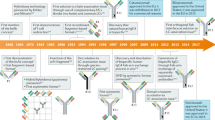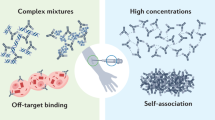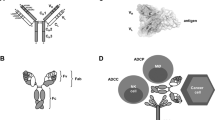Abstract
Although antibody-based therapeutics have become firmly established as medicines for serious diseases, the value of antibodies as tools in the early stages of small-molecule drug discovery is only beginning to be realized. In particular, antibodies may provide information to reduce risk in small-molecule drug discovery by enabling the validation of targets and by providing insights into the design of small-molecule screening assays. Moreover, antibodies can act as guides in the quest for small molecules that have the ability to modulate protein–protein interactions, which have traditionally only been considered to be tractable targets for biological drugs. The development of small molecules that have similar therapeutic effects to current biologics has the potential to benefit a broader range of patients at earlier stages of disease.
This is a preview of subscription content, access via your institution
Access options
Subscribe to this journal
Receive 12 print issues and online access
$209.00 per year
only $17.42 per issue
Buy this article
- Purchase on Springer Link
- Instant access to full article PDF
Prices may be subject to local taxes which are calculated during checkout


Similar content being viewed by others
References
Ramani, A. K., Bunescu, R. C., Mooney, R. J. & Marcotte, E. M. Consolidating the set of known human protein–protein interactions in preparation for large-scale mapping of the human interactome. Genome Biol. 6, R40 (2005).
Wells, J. A. & McClendon, C. L. Reaching for high-hanging fruit in drug discovery at protein–protein interfaces. Nature 450, 1001–1009 (2007).
Arkin, M. R. & Wells, J. A. Small-molecule inhibitors of protein–protein interactions: progressing towards the dream. Nature Rev. Drug Discov. 3, 301–317 (2004).
Dickens, M. P., Fitzgerald, R. & Fischer, P. M. Small-molecule inhibitors of MDM2 as new anticancer therapeutics. Semin. Cancer Biol. 20, 10–18 (2010).
Gandhi, L. et al. Phase I study of Navitoclax (ABT-263), a novel Bcl-2 family inhibitor, in patients with small-cell lung cancer and other solid tumors. J. Clin. Oncol. 29, 909–916 (2011).
Shuker, S. B., Hajduk, P. J., Meadows, R. P. & Fesik, S. W. Discovering high affinity ligands for proteins: SAR by NMR. Science 274, 1531–1534 (1996).
Hajduk, P. J. & Greer, J. A decade of fragment-based drug design: strategic advances and lessons learned. Nature Rev. Drug Discov. 6, 211–219 (2007).
Jhoti, H. Fragment-based drug discovery using rational design. Ernst Schering Found. Symp. Proc. 3, 169–185 (2007).
Murray, C. W. & Rees, D. C. The rise of fragment-based drug discovery. Nature Chem. 1, 187–192 (2009).
Valkov, E., Sharpe, T., Marsh, M., Grieve, S. & Hyvönen, M. Targeting protein–protein interactions and fragment-based drug discovery. Top. Curr. Chem. 317, 145–179 (2012).
Sun, C., Petros, A. M. & Hajduk, P. J. Fragment-based lead discovery: challenges and opportunities. J. Comput. Aided Mol. Des. 25, 607–610 (2011).
Abifadel, M. et al. Mutations in PCSK9 cause autosomal dominant hypercholesterolemia. Nature Genet. 34, 154–156 (2003).
Seidah, N. G. & Prat, A. The biology and therapeutic targeting of the proprotein convertases. Nature Rev. Drug Discov. 11, 367–383 (2012).
Crunkhorn, S. PCSK9 antibody reduces LDL cholesterol. Nature Rev. Drug Discov. 11, 11 (2012).
Paalanen, M. M. I. et al. The development of activating and inhibiting camelid VHH domains against human protein kinase C epsilon. Eur. J. Pharm. Sci. 42, 332–339 (2011).
Haque, A., Anderson, J. N., Salmeen, A., Barford, D. & Tonks, N. K. Conformation-sensing antibodies stabilize the oxidized form of PTP1B and inhibit its phosphatase activity. Cell 147, 185–198 (2011).
Visintin, M., Melchionna, T., Cannistraci, I. & Cattaneo, A. In vivo selection of intrabodies specifically targeting protein–protein interactions: a general platform for an 'undruggable' class of disease targets. J. Biotechnol. 135, 1–15 (2008).
Elbashir, S. M. et al. Duplexes of 21-nucleotide RNAs mediate RNA interference in cultured mammalian cells. Nature 411, 494–498 (2001).
DeLano, W. L. Unraveling hot spots in binding interfaces: progress and challenges. Curr. Opin. Struct. Biol. 12, 14–20 (2002).
Ganesan, R. et al. Unraveling the allosteric mechanism of serine protease inhibition by an antibody. Structure 17, 1614–1624 (2009).
Barlow, J. N., Conrath, K. & Steyaert, J. Substrate-dependent modulation of enzyme activity by allosteric effector antibodies. Biochim. Biophys. Acta 1794, 1259–1268 (2009).
Dong, J. et al. A single domain llama antibody potently inhibits the enzymatic activity of botulinum neurotoxin by binding to the non-catalytic α-exosite binding region. J. Mol. Biol. 397, 1106–1118 (2010).
Air, G. M., Webster, R. G., Colman, P. M. & Laver, W. G. Distribution of sequence differences in influenza N9 neuraminidase of tern and whale viruses and crystallization of the whale neuraminidase complexed with antibodies. Virology 160, 346–354 (1987).
Ostermeier, C., Harrenga, A., Ermler, U. & Michel, H. Structure at 2.7Å resolution of the Paracoccus denitrificans two-subunit cytochrome c oxidase complexed with an antibody Fv fragment. Proc. Natl Acad. Sci. USA 94, 10547–10553 (1997).
Kortt, A. A. et al. Recombinant anti-sialidase single chain variable fragment antibody. Characterisation, formation of dimer and higher-molecular-mass multimers and the solution of the crystal structure of the single-chain variable fragment/sialidase complex. Eur. J. Biochem. 221, 151–157 (1994).
Loris, R. et al. Crystal structure of the intrinsically flexible addiction antidote MazE. J. Biol. Chem. 278, 28252–28257 (2003).
Tereshko, V. et al. Toward chaperone-assisted crystallography: protein engineering enhancement of crystal packing and X-ray phasing capabilities of a camelid single-domain antibody (VHH) scaffold. Protein Sci. 17, 1175–1187 (2008).
Wu, M. et al. Structures of a key interaction protein from the Trypanosoma brucei editosome in complex with single domain antibodies. J. Struct. Biol. 174, 124–136 (2011).
Korotkov, K. V., Pardon, E., Steyaert, J. & Hoi, W. G. J. Crystal structure of the N-terminal domain of the secretin GspD from ETEC determined with the assistance of a nanobody. Structure 17, 255–265 (2009).
Zhou, Y., Morais-Cabral, J. H., Kaufman, A. & MacKinnon, R. Chemistry of ion coordination and hydration revealed by a K+ channel-Fab complex at 2.0Å resolution. Nature 414, 43–48 (2001).
Lam, A. Y., Pardon, E., Korotkov, K. V., Hol, W. G. & Steyaert, J. Nanobody-aided structure determination of the EpsI:EpsJ pseudopilin heterodimer from Vibrio vulnificus. J. Struct. Biol. 166, 8–15 (2009).
Iwata, S., Ostermeier, C., Ludwig, B. & Michel, H. Structure at 2.8Å resolution of cytochrome c oxidase from Paracoccus denitrificans. Nature 376, 660–669 (1995).
Streltsov, V. A., Varghese, J. N., Masters, C. L. & Nuttall, S. D. Crystal structure of the amyloid-β p3 fragment provides a model for oligomer formation in Alzheimer's disease. J. Neurosci. 31, 1419–1426 (2011).
Pai, J. C. et al. Conversion of scFv peptide-binding specificity for crystal chaperone development. Protein Eng. Des. Sel. 24, 419–428 (2011).
Prongay, A. J. et al. Preparation and crystallization of a human immunodeficiency virus p24–Fab complex. Proc. Natl Acad. Sci. USA 87, 9980–9984 (1990).
Hino, T. et al. G-protein-coupled receptor inactivation by an allosteric inverse-agonist antibody. Nature 482, 237–240 (2012).
Rasmussen, S. G. F. et al. Structure of a nanobody-stabilized active state of the β2 adrenoceptor. Nature 469, 175–181 (2011).
Rizk, S. S. et al. Allosteric control of ligand-binding affinity using engineered conformation-specific effector proteins. Nature Struct. Mol. Biol. 18, 437–444 (2011).
Domanska, K. et al. Atomic structure of a nanobody-trapped domain-swapped dimer of an amyloidogenic β2-microglobulin variant. Proc. Natl Acad. Sci. USA 108, 1314–1319 (2011).
Saragovi, H. U. et al. Design and synthesis of a mimetic from an antibody complementarity-determining region. Science 253, 792–795 (1991).
Sadowsky, J. D. et al. Turning a protein kinase on or off from a single allosteric site via disulphide trapping. Proc. Natl Acad. Sci. USA 108, 6056–6061 (2011).
Lobato, M. N. & Rabbitts, T. H. Intracellular antibodies and challenges facing their use as therapeutic agents. Trends Mol. Med. 9, 390–396 (2003).
Oyen, D., Srinivasan, V., Steyaert, J. & Barlow, J. N. Constraining enzyme conformational change by an antibody leads to hyperbolic inhibition. J. Mol. Biol. 407, 138–148 (2011).
Gao, J., Sidhu, S. S. & Wells, J. A. Two-state selection of conformation-specific antibodies. Proc. Natl Acad. Sci. USA 106, 3071–3076 (2009).
De Genst, E. J. et al. Structure and properties of a complex of α-synuclein and a single-domain camelid antibody. J. Mol. Biol. 402, 326–343 (2010).
Lafaye, P., Achour, I., England, P., Duyckaerts, C. & Rougeon, F. Single-domain antibodies recognize selectively small oligomeric forms of amyloid β, prevent Aβ-induced neurotoxicity and inhibit fibril formation. Mol. Immunol. 46, 695–704 (2009).
Habicht, G. et al. Directed selection of a conformational antibody domain that prevents mature amyloid fibril formation by stabilizing Aβ protofibrils. Proc. Natl Acad. Sci. USA 104, 19232–19237 (2007).
Dumoulin, M. et al. A camelid antibody fragment inhibits the formation of amyloid fibrils by human lysozyme. Nature 424, 783–788 (2003).
Abskharon, R. N. et al. Crystallization and preliminary X-ray diffraction analysis of a specific VHH domain against mouse prion protein. Acta Crystallogr. Sect. F Struct. Biol. Cryst. Crystallogr. 66, 1644–1646 (2010).
Mossessova, E., Corpina, R. A. & Goldberg, J. Crystal structure of ARF1*Sec7 complexed with brefeldin A and its implications for the guanine nucleotide exchange mechanism. Mol. Cell 12, 1403–1411 (2003).
Viaud, J. et al. Structure-based discovery of an inhibitor of Arf activation by Sec7 domains through targeting of protein–protein complexes. Proc. Natl Acad. Sci. USA 104, 10370–10375 (2007).
Monod, J., Changeux, J. P. & Jacob, F. Allosteric proteins and cellular control systems. J. Mol. Biol. 6, 306–329 (1963).
Christopoulos, A. Allosteric binding sites on cell-surface receptors: novel targets for drug discovery. Nature Rev. Drug Discov. 1, 198–210 (2002).
Gunasekaran, K., Ma, B. & Nussinov, R. Is allostery an intrinsic property of all dynamic proteins? Proteins 57, 433–443 (2004).
Horn, J. R. & Shoichet, B. K. Allosteric inhibition through core disruption. J. Mol. Biol. 336, 1283–1291 (2004).
González-Ruiz, D. & Gohlke, H. Targeting protein–protein interactions with small molecules: challenges and perspectives for computational binding epitope detection and ligand finding. Curr. Med. Chem. 13, 2607–2625 (2006).
Ganesan, R., Eigenbrot, C. & Kirchhofer, D. Structural and mechanistic insight into how antibodies inhibit serine proteases. Biochem. J. 430, 179–189 (2010).
Murray, C. W. & Blundell, T. L. Structural biology in fragment-based drug design. Curr. Opin. Struct. Biol. 20, 497–507 (2010).
Giannetti, A. M. From experimental design to validated hits: a comprehensive walk-through of fragment lead identification using surface plasmon resonance. Methods Enzymol. 493, 169–218 (2011).
Perspicace, S. et al. Fragment-based screening using surface plasmon resonance technology. J. Biomol. Screen. 14, 337–349 (2009).
Hämäläinen, M. D. et al. Label-free primary screening and affinity ranking of fragment libraries using parallel analysis of protein panels. J. Biomol. Screen. 13, 202–209 (2008).
Hajduk, P. J., Meadows, R. P. & Fesik, S. W. NMR-based screening in drug discovery. Q. Rev. Biophys. 32, 211–240 (1999).
Edink, E. et al. Fragment growing induces conformational changes in acetylcholine-binding protein: a structural and thermodynamic analysis. J. Am. Chem. Soc. 133, 5363–5371 (2011).
Koldobskaya, Y. et al. A portable RNA sequence whose recognition by a synthetic antibody facilitates structural determination. Nature Struct. Mol. Biol. 18, 100–106 (2011).
Tickle, S. et al. High-throughput screening for high affinity antibodies. J. Lab. Autom. 14, 303–307 (2009).
Acknowledgements
I am grateful to my colleagues at UCB for stimulating discussion and refinement of ideas.
Author information
Authors and Affiliations
Ethics declarations
Competing interests
Alastair D. G. Lawson is an employee of UCB, and holds shares and share options in the company.
Related links
Glossary
- Allosteric modulation
-
An allosteric effect (such as inhibition, which is also referred to as non-competitive inhibition) that can result from a change in the shape of an active site when an inhibitor binds at an alternative site.
- Apo structure
-
The ligand-free structure of a protein.
- Biological risk
-
In the context of this article, biological risk is the risk associated with modulating the biology of a specific target: for example, the consequences of inhibiting a particular signalling pathway.
- Complementarity determining region 3
-
(CDR3). A region found within an antibody variable region; the CDR has a highly variable amino acid sequence and confers binding specificity.
- Chemical risk
-
In the context of this article, chemical risk is the risk inherent in the therapeutic molecule itself: for example, its off-target activity as well as its pharmacokinetic and pharmacodynamic profiles.
- Chaperone
-
An auxiliary protein that binds to a target of interest, enhances crystallization, optimizes crystal packing and provides high-quality phasing information.
- Fragment-based drug discovery
-
A method that is used for finding lead compounds in drug discovery. It is based on identifying small chemical fragments, which bind relatively weakly to the biological target, and then either increasing the size of the fragments or combining them to produce a lead compound with a higher affinity and increased potency.
- Intrabodies
-
Antibodies, usually antibody fragments, that bind to targets inside a cell (such as intracellular proteins) and are typically expressed intracellularly.
- Protofibrils
-
Transient structures that are implicated as the toxic species responsible for cell dysfunction and neuronal loss in diseases associated with protein aggregation, such as Alzheimer's disease.
- Tethering
-
A technique in which a disulphide bond is used to stabilize the binding of thiol-containing fragments at a specific site on proteins where a cysteine residue has been engineered.
Rights and permissions
About this article
Cite this article
Lawson, A. Antibody-enabled small-molecule drug discovery. Nat Rev Drug Discov 11, 519–525 (2012). https://doi.org/10.1038/nrd3756
Published:
Issue Date:
DOI: https://doi.org/10.1038/nrd3756
This article is cited by
-
Peptide-Based Therapeutics in Cancer Therapy
Molecular Biotechnology (2023)
-
A conformation-selective monoclonal antibody against a small molecule-stabilised signalling-deficient form of TNF
Nature Communications (2021)
-
Spatiotemporal identification of druggable binding sites using deep learning
Communications Biology (2020)
-
Small molecules that inhibit TNF signalling by stabilising an asymmetric form of the trimer
Nature Communications (2019)
-
Discovery of a junctional epitope antibody that stabilizes IL-6 and gp80 protein:protein interaction and modulates its downstream signaling
Scientific Reports (2017)



